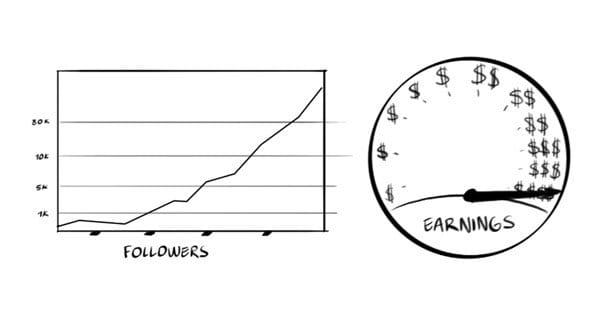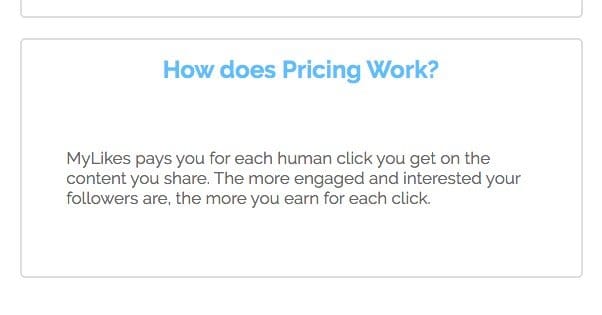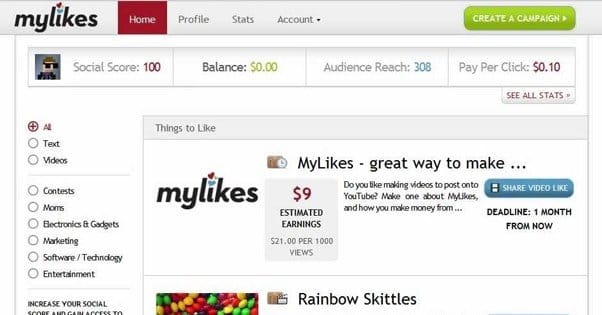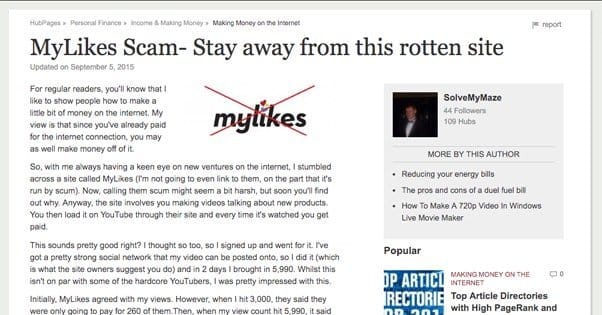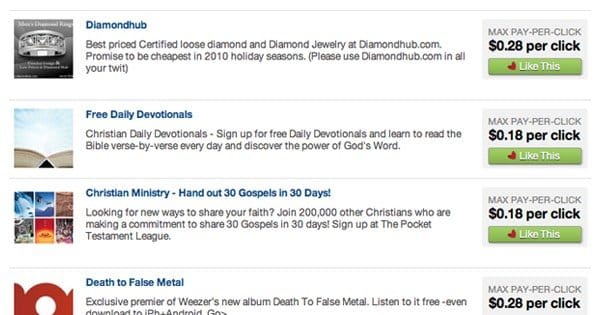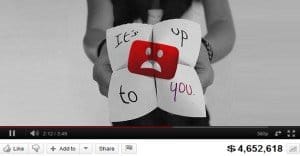 Written by ContentPowered.com
Written by ContentPowered.com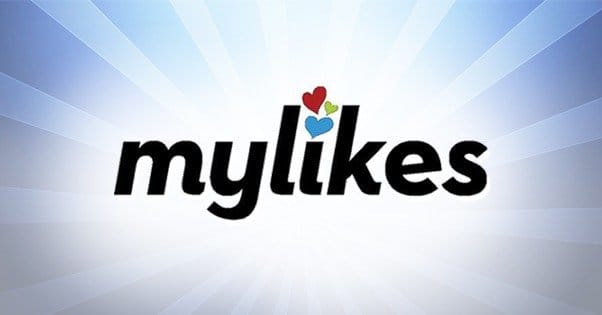
MyLikes, despite the name implying a social network or likes seller of some sort, is actually a fairly typical advertising network with a social angle. It tries to take advantage of influencers who have existing audiences, but it’s not great for newcomers or novice publishers.
How Does MyLikes Work?
The general process is pretty simple. When you sign up, you get web hosting space similar to an old freehost or a Wix site. It’s hosted on one of their domains. You then browse through their library of socially viral content and add it to your site, similar to a curated social feed. When your followers – or anyone you can get to visit your site, really – click on any of the content, you are paid for that content.
If you look under the hood, you realize that the content in their library is all advertising content from companies looking for exposure. Advertisers promise to pay for clicks, and MyLikes sends those clicks. It’s all very much like PPC ads, except it allows publishers to curate which “ads” they want in their sites, and the publishers then have to figure out a way to get people to visit their curated sites.
One of the most common ways people drive traffic to their likes site is through YouTube. MyLikes doesn’t care where the traffic comes from, though. All they care about is that the traffic is legitimate and that it clicks on content to visit their advertisers. Only when that happens does the site get paid, and only when the site is paid do you get paid.
Like any advertising platform, MyLikes heavily filters clicks to ads to eliminate fraudulent activity. This leads to situations where you might see 6,000 clicks sent from your site to theirs, but only 2,000 referred through to advertisers and paid. There are a lot of bots and a lot of fake users out there, and they end up filtered. Ideally, this makes it so that you’re not able to muddy the waters with fake traffic, which puts downward pressure on prices and hurts everyone involved. In practice, well, that all depends on how good their filter is.
Payments are, surprisingly, quite simple. MyLikes issues payments once per week via PayPal, and they pay out to anyone who has a balance of over $20. They also offer monthly ACH or wire transfers, if you prefer.
- Sign up for MyLikes as a publisher.
- You are given a custom website; set it up and configure it to suit your audience and your brand.
- Drive traffic to your viral content hub via whatever sources you prefer, be it YouTube videos, Facebook posts, Twitter tweets or something else.
- Earn money when people click on the curated content in your site.
The trick here is that you don’t need to produce or even pay a lot of attention to the content you’re sharing. MyLikes and the advertisers involved are the ones who create the content, you as a publisher just have to share it and drive traffic to it.
Combined, MyLikes operates very much like a cross between a PPC network and affiliate marketing. From the publisher end it’s a lot more like affiliate marketing, where you’re trying to generate leads. From the advertiser end it’s a lot more like PPC, complete with campaigns with a cost per click setting and a weekly budget.
I was a little inaccurate above, when I said that all of the content on MyLikes is paid for by advertisers. Because the publisher gets to curate the content on their site, it would make advertising budgets inoperative. Instead, most of the content is created or curated by the MyLikes team, and the advertising content is seeded in.
Publisher and Advertiser Payments
MyLikes has a system in place for rating publishers based on the quality and volume of the traffic they refer. It’s a lot like a Facebook or Google AdWords quality score. Publishers who refer low quality or filtered traffic tend to have their quality score demoted, while publishers sending better traffic in higher volumes have a higher quality score.
This means that publishers with a lower score are paid less, and consequently get more seeds from advertisers who have lower budgets. Advertisers with higher budgets can pay for traffic from higher quality publishers, who earn more for their traffic due to their higher quality score. It pays, literally, to refer good traffic.
Advertisers are given some targeting options, including age, geographic location, device, and some other demographics and interests. However, this targeting is nowhere near as robust as what you might find through Facebook.
I will say this: MyLikes has good analytics going for them. Because everything is hosted on their domain, they are able to track data in real time, and can show you what actions the user took to get to the ads and how their behaviors line up. This is useful for more than just optimizing on MyLikes; it can show you information about your audience that you might not have known before.
Oh, and in case you’re worried about publishing ads for companies you don’t want to support, or as an advertiser worried about putting your brand in with a bunch of nobodies, don’t. There are some sizable companies advertising with MyLikes, including CBS, Virgin Mobile, and Tru TV.
How much, specifically, does MyLikes pay?
Well, it varies wildly. I’ve seen reports of content than earns four tenths of a penny per click, and I’ve seen reports of content than earns 25 cents per click. You can’t see earnings until you’re registered, and they will vary as your quality score changes.
Is MyLikes a Scam?
MyLikes claims that top publishers are making $50,000 per month. On the other hand, the Internet is rife with people reviewing the site, and a lot of them read like paid affiliates. One particular review claims it’s a scam, so let’s look at their claims.
First, the user essentially just posted one video and got enough to earn a meager $80, and when the views to their YouTube video were deemed illegitimate and their “earnings” went down, they went off. The logical flaw with this here is that they didn’t earn that $80, they had the potential pre-review of earning that $80. No one in ads publishing expects 100% of their views to get them paid, there are just too many fake users floating around.
Now, I’m not going to claim that this user sent fake views and decided to lie for Google popularity and a #1 spot for MyLikes Scam on Google. On the other hand, I’m not going to say they’re completely in the right. There’s a reason YouTube videos fluctuate and drop; there are tons of fake viewers on the site at any given time. No filtering method is perfect, and it’s obvious that MyLikes and YouTube use different filtering methods. Here’s the thing; even if YouTube deemed the view illegitimate, that just removes it from the YouTube view count, not from the referral to MyLikes. MyLikes still gets to filter and remove it too.
Now, the fact that the user was subsequently banned from the platform could be coming from a number of different sources. Maybe they did send fake views and were blocked for it. This is not unheard of from ad networks. Maybe they violated another rule that was outside of the terms of service for MyLikes. Or maybe they did actually get banned for writing a high ranking article slandering the service. I don’t know.
Either way, it’s a lot of trouble over $80. So let’s look at the other side of the coin, someone who calls the site completely legitimate and promotes it. This one should do nicely. It’s at a comparable level, with the author earning around $100 as of writing the post, but they weren’t banned.
This post points out one thing that I find worrying. MyLikes had a handful of custom domains, like humorable.org, that it staples to the username you choose to make your site domain name. This leads to things like username.dailysmh.me, which is not a very pleasant URL to look at. Personally, if I say it on Facebook, I would figure it was probably spam. Others seem to have the same opinion. This post does say, however, that you can use your own custom domain with MyLikes. I don’t know if this is true or not, but if it is, by all means; make use of it.
They do helpfully elucidate the process of curating content for your custom site, which is helpful. The MyLikes database is filled with content you can pick through to curate, and this poster points out that a lot of it is designed to be risqué and some of it comes off as spammy. Regardless, you can filter through it to find the content you think your audience would be most interested in seeing.
Apparently, you can create your own content and have it added to the MyLikes library. This allows you to add content you know your users would like, and have it monetized through MyLikes in addition to however you actually monetize it. Further, other people can then share it through their pages, and you get some of the earnings from those users, due to the content coming from you.
Who Best Uses MyLikes?
In my opinion, if you don’t already have an audience built up on social media, you’re not going to do very well on MyLikes. It, like any other form of PPC or affiliate advertising, requires a good deal of traffic to make any serious returns. If you don’t have that sort of presence, you’re not going to bring in the kinds of traffic you need to earn anything significant.
Alternatively, you can become a content producer and make all of your cash from them via royalties on content you add to the database. In this instance, you have to know the kinds of people using MyLikes more than you have to know the audience you’re sharing to. You become a sort of middleman, and by producing good content that is added to a ton of galleries, you can make quite a bit. However, you earn less through indirect shares than you do through direct traffic, so this method will require even more work than using the platform as a normal publisher.
From the advertiser side, you can probably guess the sorts of people who use the site. These are going to be your webmasters, your geeks, your stay at home workers, your bloggers. Technology and risqué content tends to do well, which is why there’s so much of it. If you’re in that sort of niche, and you have the budget to spend, you can get some good returns from the site. If you’re not in one of those niches, you’ll want to do some deeper investigation and maybe some basic low-budget campaigns to trial it out first.
There’s also always the black hat contingent. These people go in monetizing it as much automatically as possible, using various services that can get them banned from MyLikes, so that’s always a risky method. As always with Black Hat World, though, take their advice with a grain of salt. Users there are always in search of a way to automate moneymaking, and they almost always spend more money and take more time doing it than taking a more white hat route would get them.
Honestly, though, the barrier for entry into MyLikes is so low I feel like there’s no reason you can’t just give it a try. There are a ton of options to explore and you might hit upon a high quality niche. If it doesn’t work, you didn’t waste a lot of time, so you’re fine to abandon it.
The Changing World
One thing to note about MyLikes is that this post – and most other posts about the site – are likely going to be out of date in six months. The site keeps changing the way they work, in an effort to please everyone on both sides of the network. Methods that work now might not work later, and methods that work later might not exist now. Keep this in mind; not all information you read is accurate or up to date. Check the date stamps on the posts you read before you form your opinions.
